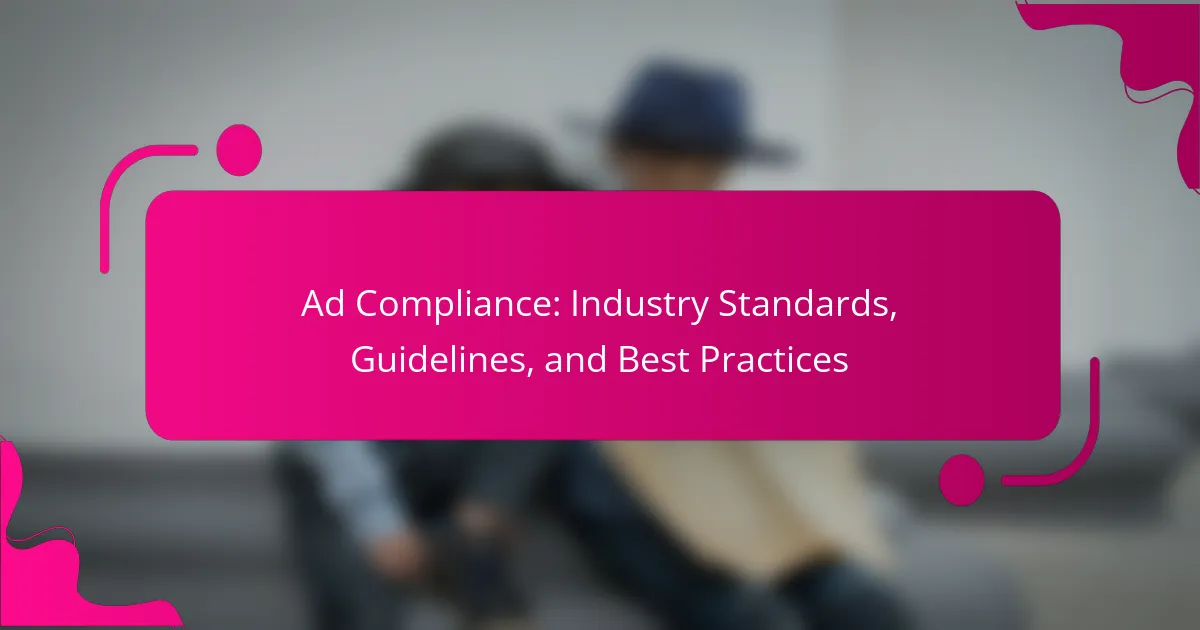Ad compliance is crucial for maintaining integrity in advertising and protecting consumers from misleading information. In the UK, key regulations set by the Advertising Standards Authority (ASA) and the Committee of Advertising Practice (CAP) guide businesses in creating legal and truthful advertisements. By implementing regular audits and training, companies can navigate common pitfalls and enhance their brand reputation while adhering to industry standards.

What are the key ad compliance standards in the UK?
The key ad compliance standards in the UK include regulations set by the Advertising Standards Authority (ASA), the Committee of Advertising Practice (CAP), and Ofcom. These standards ensure that advertisements are legal, decent, honest, and truthful, protecting consumers from misleading information.
Advertising Standards Authority (ASA) guidelines
The ASA is the UK’s independent regulator for advertising across all media. It enforces the advertising codes and ensures that ads are not misleading, harmful, or offensive. Advertisers must ensure their claims can be substantiated and that they do not exploit vulnerable audiences.
To comply with ASA guidelines, businesses should regularly review their advertising content and seek pre-clearance for complex claims. Common pitfalls include making exaggerated claims or failing to include necessary disclaimers.
CAP Code requirements
The CAP Code outlines specific rules for advertising, including requirements for honesty, transparency, and social responsibility. Advertisers must ensure that their messages are clear and do not mislead consumers about the nature or benefits of a product or service.
Key elements of the CAP Code include the necessity for clear pricing, the prohibition of misleading endorsements, and guidelines for advertising to children. Businesses should conduct regular audits of their marketing materials to ensure compliance with these standards.
Ofcom regulations
Ofcom regulates communications in the UK, including broadcasting and telecommunications advertising. Their regulations focus on protecting viewers from harmful content and ensuring that advertisements are clearly distinguishable from programming.
Advertisers must adhere to Ofcom’s rules regarding the timing and placement of ads, particularly in children’s programming. It’s essential to stay updated on these regulations, as non-compliance can lead to significant penalties and damage to brand reputation.

How can businesses ensure ad compliance?
Businesses can ensure ad compliance by implementing a combination of regular audits, training for their marketing teams, and utilizing compliance software. These strategies help maintain adherence to industry standards and regulations, reducing the risk of penalties and enhancing brand reputation.
Regular compliance audits
Conducting regular compliance audits is essential for identifying potential issues in advertising practices. These audits should assess adherence to relevant regulations, such as truth in advertising laws and data protection standards. Scheduling audits quarterly or bi-annually can help businesses stay proactive in addressing compliance gaps.
During an audit, businesses should review all advertising materials, including digital ads, print media, and promotional campaigns. Creating a checklist that includes key compliance areas can streamline this process and ensure thorough evaluations.
Training for marketing teams
Providing training for marketing teams is crucial for fostering a culture of compliance within the organization. Regular workshops and seminars can educate team members about current regulations and best practices, ensuring everyone is on the same page. This training should cover topics such as ethical advertising, consumer rights, and data privacy.
Consider implementing a mentorship program where experienced team members guide newer employees on compliance matters. This hands-on approach can reinforce learning and help prevent compliance issues from arising in the first place.
Utilizing compliance software
Utilizing compliance software can significantly enhance a business’s ability to monitor and manage advertising compliance. These tools often include features like automated checks for regulatory adherence, tracking changes in laws, and generating compliance reports. Investing in such software can save time and reduce the risk of human error.
When selecting compliance software, businesses should look for solutions that integrate with existing marketing platforms. This integration can streamline workflows and ensure that compliance checks are part of the advertising process from the outset.

What are the common pitfalls in ad compliance?
Common pitfalls in ad compliance include misleading claims, inadequate disclosures, and ignoring audience targeting rules. These issues can lead to regulatory penalties and damage to brand reputation, making it essential for advertisers to understand and avoid them.
Misleading claims
Misleading claims occur when advertisements present information that can deceive consumers about a product’s benefits or features. For example, stating that a product is “the best” without evidence can mislead potential buyers.
To avoid this pitfall, ensure all claims are substantiated with reliable evidence. Use clear, factual language and avoid exaggeration to maintain transparency and trust with your audience.
Inadequate disclosures
Inadequate disclosures refer to failing to provide necessary information that consumers need to make informed decisions. This includes not clearly stating terms and conditions, or omitting material information about costs or risks associated with a product.
To comply, always include relevant disclosures in a prominent and understandable manner. For instance, if an advertisement promotes a financial product, clearly outline any fees or interest rates involved to avoid misleading consumers.
Ignoring audience targeting rules
Ignoring audience targeting rules can lead to ads being shown to inappropriate audiences, which may violate regulations. For example, targeting ads for alcohol to minors is not only unethical but also illegal in many jurisdictions.
To ensure compliance, familiarize yourself with local advertising regulations regarding audience targeting. Implement robust age verification processes and regularly review targeting settings to prevent misalignment with legal standards.

What are the best practices for display advertising compliance?
Best practices for display advertising compliance focus on ensuring that ads are truthful, transparent, and adhere to relevant regulations. Implementing these practices helps maintain consumer trust and minimizes legal risks.
Clear messaging and transparency
Clear messaging is essential in display advertising to avoid misleading consumers. Advertisers should ensure that the content is straightforward and accurately represents the product or service being promoted. Transparency about pricing, terms, and conditions is crucial to foster trust.
Using clear calls to action and avoiding ambiguous language can help consumers understand what is being offered. For example, instead of saying “Get a great deal,” specify “Save 20% on your first purchase.” This clarity reduces confusion and enhances compliance.
Ad content review processes
Establishing a robust ad content review process is vital for compliance. This process should include checks for accuracy, appropriateness, and alignment with industry standards. Involving legal and compliance teams in the review can help identify potential issues before ads go live.
Consider creating a checklist that includes key compliance elements such as truthfulness, relevance, and adherence to platform guidelines. Regular audits of past campaigns can also provide insights into areas for improvement.
Staying updated with legal changes
Staying informed about legal changes is critical for maintaining compliance in display advertising. Laws and regulations can vary significantly by region and may evolve over time, affecting advertising practices. Regularly reviewing updates from regulatory bodies can help advertisers stay compliant.
Subscribing to industry newsletters or joining professional organizations can provide valuable insights into emerging trends and legal requirements. Additionally, conducting periodic training sessions for your team can ensure everyone is aware of the latest compliance standards.

How does ad compliance impact brand reputation?
Ad compliance significantly influences brand reputation by establishing trust with consumers and ensuring adherence to legal standards. Brands that prioritize compliance demonstrate integrity, which can enhance customer loyalty and attract new audiences.
Trust and credibility enhancement
Adhering to compliance standards builds trust and credibility with consumers. When brands follow industry guidelines, they signal to customers that they are responsible and transparent, which can lead to stronger relationships and repeat business.
For example, brands that clearly disclose sponsored content or adhere to truth-in-advertising laws are often viewed more favorably. This transparency can differentiate them from competitors who may not prioritize compliance.
Risk of penalties and fines
Non-compliance with advertising regulations can result in significant penalties and fines, which can damage a brand’s financial health and reputation. Regulatory bodies may impose fines that range from thousands to millions of dollars, depending on the severity of the violation.
Brands should regularly review their advertising practices to ensure they align with local regulations, such as the Federal Trade Commission (FTC) guidelines in the U.S. or the General Data Protection Regulation (GDPR) in Europe, to avoid costly repercussions.
Consumer perception management
Consumer perception is heavily influenced by a brand’s compliance with advertising standards. Brands that are frequently associated with misleading ads or non-compliance can suffer long-term damage to their image, leading to decreased customer trust and loyalty.
To manage consumer perception effectively, brands should actively monitor feedback and engage with their audience regarding advertising practices. Proactively addressing concerns and maintaining open communication can help mitigate negative perceptions and reinforce a positive brand image.

What tools can assist with ad compliance monitoring?
Ad compliance monitoring can be effectively supported by various tools designed to ensure adherence to industry standards and regulations. These tools help advertisers and agencies track, verify, and manage their advertising content to avoid potential legal issues and maintain brand integrity.
Ad verification platforms
Ad verification platforms are specialized tools that assess whether ads meet specified standards before they are published. They check for compliance with guidelines related to content, placement, and audience targeting, ensuring that ads do not violate regulations or brand policies.
Key features of these platforms often include real-time monitoring, fraud detection, and reporting capabilities. Popular options include Integral Ad Science, DoubleVerify, and Moat, which provide insights into ad visibility, viewability, and brand safety.
Compliance management systems
Compliance management systems help organizations streamline their processes for adhering to legal and regulatory requirements. These systems often include features for documentation, workflow management, and audit trails, making it easier to manage compliance across various advertising channels.
When selecting a compliance management system, consider factors such as integration capabilities, user-friendliness, and the ability to customize workflows. Tools like ComplyAdvantage and LogicManager are examples that can assist in maintaining compliance while managing risks effectively.
